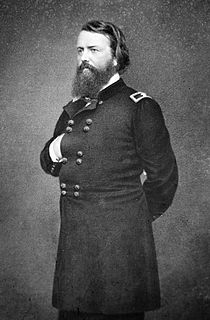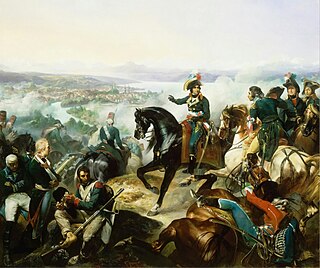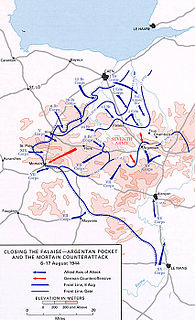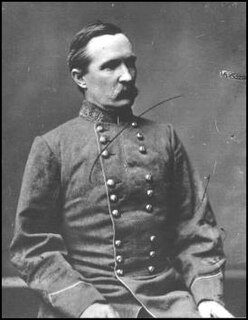Related Research Articles

The Battle of the Wilderness was fought on May 5–7, 1864, during the American Civil War. It was the first battle of Lieutenant General Ulysses S. Grant's 1864 Virginia Overland Campaign against General Robert E. Lee and the Confederate Army of Northern Virginia. The fighting occurred in a wooded area near Locust Grove, Virginia, about 20 miles (32 km) west of Fredericksburg. Both armies suffered heavy casualties, nearly 29,000 in total, a harbinger of a war of attrition by Grant against Lee's army and, eventually, the Confederate capital, Richmond, Virginia. The battle was tactically inconclusive, as Grant disengaged and continued his offensive.

The Second Battle of Boulou was a battle in the War of the Pyrenees, part of the French Revolutionary Wars. This battle saw the French Army of the Eastern Pyrenees led by Jacques François Dugommier attacking the joint Spanish-Portuguese Army of Catalonia under Luis Firmín de Carvajal, Conde de la Unión. Dugommier's decisive victory resulted in the French regaining nearly all the land they lost to the Kingdom of Spain in 1793. Le Boulou is on the modern A9 highway, 20 kilometres (12 mi) south of the department capital at Perpignan and 7 kilometres (4 mi) north of Le Perthus on the France-Spain border.

James Birdseye McPherson was a career United States Army officer who served as a general in the Union Army during the American Civil War. McPherson was on the General's staff of Henry Halleck and later, of Ulysses S. Grant and was with Grant at the Battle of Shiloh. He was killed at the Battle of Atlanta, facing the army of his old West Point classmate John Bell Hood, who paid a warm tribute to his character. He was the second-highest-ranking Union officer killed in action during the war.

The Army of Tennessee was the principal Confederate army operating between the Appalachian Mountains and the Mississippi River during the American Civil War. It was formed in late 1862 and fought until the end of the war in 1865, participating in most of the significant battles in the Western Theater.

John Pope was a career United States Army officer and Union general in the American Civil War. He had a brief stint in the Western Theater, but he is best known for his defeat at the Second Battle of Bull Run in the East.

The Battle of Hamel was a successful attack by Australian Army and US Army infantry, supported by British tanks, against German positions in and around the town of Le Hamel, in northern France, during World War I. The attack was planned and commanded by Lieutenant General John Monash, commander of the Australian Corps, and took place on 4 July 1918.

The Second Battle of Zurich was a key victory by the Republican French army in Switzerland led by André Masséna over an Austrian and Russian force commanded by Alexander Korsakov near Zürich. It broke the stalemate that had resulted from the First Battle of Zurich three months earlier and led to the withdrawal of Russia from the Second Coalition. Most of the fighting took place on both banks of the river Limmat up to the gates of Zürich, and within the city itself.
Feint is a French term that entered English via the discipline of swordsmanship and fencing. Feints are maneuvers designed to distract or mislead, done by giving the impression that a certain maneuver will take place, while in fact another, or even none, will. In military tactics and many types of combat, there are two types of feints: feint attacks and feint retreats.

A counterattack is a tactic employed in response to an attack, with the term originating in "war games". The general objective is to negate or thwart the advantage gained by the enemy during attack, while the specific objectives typically seek to regain lost ground or destroy the attacking enemy.

The Battle of Kennesaw Mountain was fought on June 27, 1864, during the Atlanta Campaign of the American Civil War. It was the most significant frontal assault launched by Union Maj. Gen. William T. Sherman against the Confederate Army of Tennessee under Gen. Joseph E. Johnston, ending in a tactical defeat for the Union forces. Strategically, however, the battle failed to deliver the result that the Confederacy desperately needed—namely a halt to Sherman's advance on Atlanta.

Henry Heth was a career United States Army officer who became a Confederate general in the American Civil War.
The Battle of Utoy Creek was fought August 4–7, 1864, during the Atlanta Campaign of the American Civil War. Maj. Gen. William T. Sherman's Union armies had partially encircled the city of Atlanta, Georgia, which was being held by Confederate forces under the command of General John Bell Hood. Sherman had at this point adopted a strategy of attacking the railroad lines into Atlanta, hoping to cut off his enemies' supplies. This was the third direct attack on Confederate positions during the campaign and the effect of success would have ended the siege and won Atlanta on 6 August 1864.

During the second day of the Battle of Gettysburg Confederate Gen. Robert E. Lee attempted to capitalize on his first day's success. His Army of Northern Virginia launched multiple attacks on the flanks of the Union Army of the Potomac, commanded by Maj. Gen. George G. Meade. The assaults were unsuccessful, and resulted in heavy casualties for both sides.

The Battle of Te-li-ssu, also called Battle of Wafangou after the nearby railway station, was a land battle of the Russo-Japanese War. It was fought at a hamlet some 80 mi (130 km) north of Port Arthur, Manchuria. The hamlet is known today as Délì-sì, and is located just north of Wafangdian, Liaoning Province, China. It was fought on 14–15 June 1904 between the Japanese Second Army under General Oku Yasukata and the Russian First Siberian Army Corps under Lieutenant General Georgii Stackelberg.
Envelopment is the military tactic of seizing objectives in the enemy's rear with the goal of destroying specific enemy forces and denying them the ability to withdraw. Rather than attacking an enemy head-on as in a frontal assault an envelopment seeks to exploit the enemy's flanks, attacking them from multiple directions and avoiding where their defenses are strongest. A successful envelopment lessens the number of casualties suffered by the attacker while inducing a psychological shock on the defender and improving the chances to destroy them. An envelopment will consist of one or more enveloping forces, which attacks the enemy's flank(s), and a fixing force, which attacks the enemy's front and "fixes" them in place so that they cannot withdraw or shift their focus on the enveloping forces. While a successful tactic, there are risks involved with performing an envelopment. The enveloping force can become overextended and cut off from friendly forces by an enemy counterattack, or the enemy can counterattack against the fixing force.

The Battle of the Black Mountain was fought from 17 to 20 November 1794 between the army of the First French Republic and the allied armies of the Kingdom of Spain and the Kingdom of Portugal. The French, led by Jacques François Dugommier defeated the Allies, who were commanded by Luis Firmín de Carvajal, Conde de la Unión. Though the Spanish right wing held, its left flank was driven back on the first day's fighting. On the last day of the battle, the French overran a key position and put the Spanish army to rout. The battle was remarkable in that both army commanders were slain. A Spanish artillery shell killed Dugommier early in the battle and Dominique Catherine de Pérignon assumed command of the French army. De la Union was shot dead while leading a cavalry charge on the last day of the fighting and was temporarily replaced by Jerónimo Girón-Moctezuma, Marquis de las Amarilas. The French victory led to the capture of Figueres and the Siege of Roses (Rosas), a port in Catalonia.

Clement Edson Warner was an American farmer, Republican politician, and Union Army officer in the American Civil War. He served with the 36th Wisconsin Infantry Regiment and commanded the regiment near the end of the war. He later served in the Wisconsin State Senate (1867–1869) and the Assembly (1883–1885), representing Dane County. In historical documents, his name is frequently abbreviated as C. E. Warner.

The Battle of Pered, fought on 20–21 June 1849, was one of the battles which took place in the Summer Campaign of the Hungarian War of Independence from 1848 to 1849, fought between the Hungarian Revolutionary Army and the Habsburg Empire helped by Russian troops. The Hungarian army was led by General Artúr Görgei, while the imperial army by Lieutenant field marshal Julius Jacob von Haynau. After several preliminary minor battles of the Hungarian and Austrian troops along the Vág river, in which the attacking Hungarians could not achieve success, Görgei took the command of his troops, and after receiving reinforcements, on 20 June, put his troops to attack again towards West. Although the II. Hungarian army corps occupied in heavy fights the village of Pered, the other two corps were unsuccessful, and could not advance. The angered Görgei removed the commander of the III. corps, General Károly Knezić because of his inactivity, and Colonel Lajos Asbóth, the commander of the II. corps who, in contrast to Knezić, was the only commander who accomplished his duties. While Knezić's place was taken by Colonel Károly Leiningen-Westerburg, who was a great choice, Asbóth's place was taken by Colonel József Kászonyi, who was an explicitly bad choice. Haynau, who on the first day of the battle was moving the bulk of his troops to cross the Danube to start an attack on its southern bank, sent three of his corps, which were still on the northern bank, to repel the Hungarian forces. The two Austrian and one Russian corps started their attack on 21 June and forced the Hungarians to retreat from Pered and Zsigárd, which forced Görgei to order his troops to retreat from the battlefield.
References
- ↑ Joint Chiefs of Staff (1987). Department of Defense Dictionary of Military and Associated Terms. DIANE Publishing. p. 151. ISBN 978-1-4289-8045-7.